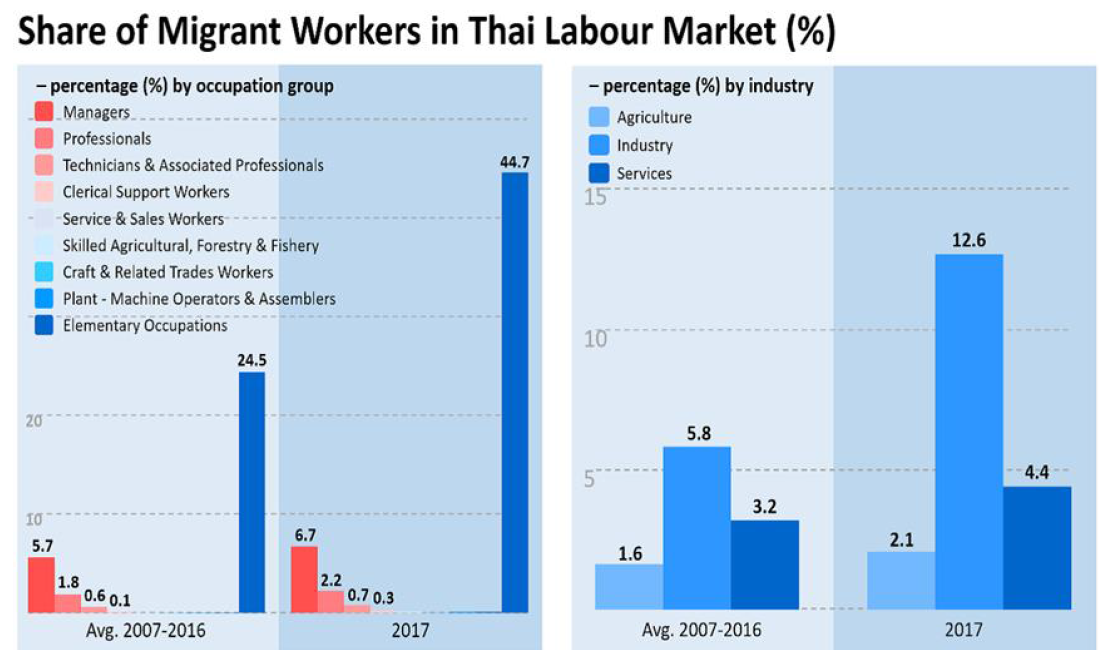Lifestyles of Myanmar migrant workers under Thai socio-cultural context: A challenge of state management in the future
Main Article Content
Abstract
In recent decades, millions of labors have gradually migrated to the destination countries in search of better economic opportunities and more fulfilling way of their lives. In Thailand, labor migration is highly affected in driving the Thai economic growth, especially increasing of total factor productivity due to efficiency gains generated by increased specialization in the labor forces. Concurrently, a rapid economic growth causing labor shortage, neighboring countries encounter the economic recession, lack of quality of life and migrants illegally immigrate into Thailand to find work. Around 3.7 million migrants are living in Thailand, however, most of them are from Myanmar which accounted for 79.28%. This study has aimed to investigate the context of wider lifestyle choices that Burmese migrants made. The participatory action approach was applied to explore and reflect the migrants' certain livelihood in Samut Sakhon Province of Thailand. The major finding shows means of Burmese migrant's livelihood when the most surviving and earning for their families and living in Burmese migrant communities located in the down town city. The essential conditions which drive migrant laborers to migrate to Thailand are the cycle-like process involving children, family, and social networks of migrant workers. Most of them recognize the benefits of Thai language adaptation as it will facilitate them to have better lives. However, many of them face difficulties in terms of lacking recognition and accessibility of their labor rights and public services. To solve these problems, it is essential for all migrants to improve Thai language skills along with better understanding of Thailand's legislation and regulations. In addition, relevant governmental agencies should join hands with employers to establish a protocol for the promotion and protection of migrants' rights. Particularly, all relevant institutions should seek the inclusion of the migrant community in developing policies, practices, and responses to help establish appropriate interventions to reduce the abuse, exploitation, and trafficking of migrant domestic workers. Finally, this welfare policy of migrant workers can be implemented successfully through adopting a holistic approach and collaboration among departments; economic and social development, education, public health, and human rights.
Article Details
References
A. Hall, Migration and Thailand: Policy, perspectives and challenges, in J. Huguet, A. Chamratrithirong (Eds.), Migration for development in Thailand: Overview and tools for policymakers (IOM, Bangkok), 2011.
United Nations, Department of economic and social affairs, Population division. (2013). Trends in international migrant stock: The 2013 Revision, http://www.un.org/en/ development /desa/population/publications/pdf/migration/migrant-stock-age-2013.pdf.
TFWAO- Thailand Foreign Workers Administration Office, Report on migrant workers in March 2016, https://www.doe.go.th /prd/assets/upload/files/alien_th/de5506d48ae2ed4916e1a6250 9b44f4f.pdf (accessed 8 May 2016).
United States National Occupational Employment and Wage Estimates, Bls.gov. (accessed 1 January 2014).
Foreign Workers Administration, Report on Migrant Workers in March 2016, https://www.doe.go.th/prd/assets/upload/files /alien_th/de5506d48ae2ed4916e1a62509b44f4f.pdf (in Thai) (accessed 8 May 2016).
Samut Sakhon Provincial Service Center, Foreign workers database, 3 nationalities, www.samutsakhon.go.th/support408 53/source/worker53.pdf (accessed 7 September 2011)
D. Bogenhold, Social inequality and the sociology of life style: Material and cultural aspects of social stratification, American Journal of Economics and Sociology 60(4) (2011) 829 - 847.
TFWAO- Thailand Foreign Workers Administration Office, Summary of the labor force survey in Thailand: March 2017, http://wp.doe.go.th (accessed 10 October 2017).
L. Gibbs, M. Kealy, K. Willis, J. Green, N. Welch, J. Daly, What have sampling and data collection got to do with good qualitative research?, Australian and New Zealand Journal of Public Health 31 (2007) 540 - 544.
S. Hutchinson, H. Wilson, Research and therapeutic interviews: A poststructuralist perspective, In critical issues in qualitative research methods, Thousand Oaks, CA: Sage, 1994.
S. Srakaew, Assessing the Situation of the Worst Forms of Child Labour in Samuth Sakhon, Bangkok: Asian Research Centre for Migration Chulalongkorn University, 2006.
W. H. Mobley, Intermediate linkages in the relationship between job satisfaction and employee turnover, Journal of Applied Psychology 62(2) (1997) 237 - 240.
A. Helseth, M. Stervander, J. Waldenstrom, Migration patterns, population trends and morpho-metrics of Ruddy Turnstones Arenaria interpressing Ottenby in south-eastern Sweden, Ornis Svecica 15 (2005) 63-72.
L. F. Berkman, T. Glass, Social integration, social networks, social support, and health. In: L. F. Berkman, I. Kawachi, Social Epidemiology, New York: Oxford University Press, Inc; 2000.
J. T. Fawcett, Networks, Linkages and migration systems, International Migration Review, Special Silver Anniversary Issue, 23(3) (1989) 671-680.
Asian Research Center for Migration (ARCM), Thailand: Improving Migration Policy Management with Special Focus on Irregular Labour Migration: Construction Sector, Unpublished Paper prepared for International Organization for Migration/International Labour Organization project, 2002.
K. Archavanitkul, A. Hall, Migrant Workers and Human Rights in a Thai Context, In Thailand Migration Report 2011, Bangkok: International, 2011.
S. Chantavanich, P. Vangsiriphaisal, S. Laodumrongchai, Labour migration in the greater Mekong subregion: Thailand policies towards Migrant Workers from Myanmar, Bangkok: Asian Research Center for Migration, Institute of Asian Studies, Chulalongkorn University, 2006.
P. J. Boyle, K. Halfacree, V. Robinson, Exploring contemporary migration, Harlow: Prentice Hall, 1998.


